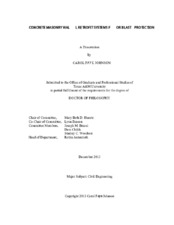| dc.contributor.advisor | Hueste, Mary Beth | |
| dc.contributor.advisor | Beason, Lynn | |
| dc.creator | Johnson, Carol Faye | |
| dc.date.accessioned | 2014-05-13T17:29:20Z | |
| dc.date.available | 2015-12-01T06:31:22Z | |
| dc.date.created | 2013-12 | |
| dc.date.issued | 2013-12-11 | |
| dc.date.submitted | December 2013 | |
| dc.identifier.uri | https://hdl.handle.net/1969.1/151905 | |
| dc.description.abstract | The increased threat against government and public facilities in the United States and abroad has highlighted the need to provide an economic and efficient method to retrofit existing conventional structures. Hollow, unreinforced, concrete masonry unit (CMU) infill walls, commonly used in reinforced concrete or steel framed structures, are particularly vulnerable to blast loads. Facilities that incorporate CMU walls must either be hardened or retrofitted for explosive events. Conventional retrofit techniques that focus on increasing the overall strength of the structure by adding steel or concrete are difficult to implement, time consuming, expensive, and in some cases, increase the debris hazard. The current research presents an alternative retrofit system for CMU walls that involves the application of an elastomeric material applied to the interior surface of the wall to prevent secondary debris in the form of CMU fragments from entering the structure when it is exposed to blast loads.
The experimental program used to evaluate the alternative retrofit systems was divided into three phases. In Phase one, resistance functions for seven different retrofit systems were developed in 24 subscale static experiments. In Phase two, the structural response of the retrofit systems subjected to blast loads was evaluated in 25 subscale experiments. The final phase of the experimental program consisted of 18 full-scale high-explosive (HE) experiments used to validate the structural response observed in the subscale dynamic experiments.
Data generated from the experimental program were used to develop a single-degree-of-freedom (SDOF) model to predict the mid-span deflection of the retrofitted CMU walls subjected to blast loads. The subscale resistance functions from Phase one were scaled and used in the SDOF model. The full-scale experimental results and the predicted results from the model were compared and the retrofit systems were ranked according to the qualitative and quantitative results obtained from the experimental and analytical research. | en |
| dc.format.mimetype | application/pdf | |
| dc.language.iso | en | |
| dc.subject | Concrete Masonry Units | en |
| dc.subject | CMU | en |
| dc.subject | Retrofit | en |
| dc.subject | Upgrade | en |
| dc.subject | Elastomer | en |
| dc.subject | Debris Hazard | en |
| dc.subject | Concrete Blocks | en |
| dc.subject | Dynamic Load | en |
| dc.subject | Cinder Blocks, Single-Degree-of-Freedom | en |
| dc.subject | | en |
| dc.title | Concrete Masonry Wall Retrofit Systems for Blast Protection | en |
| dc.type | Thesis | en |
| thesis.degree.department | Civil Engineering | en |
| thesis.degree.discipline | Civil Engineering | en |
| thesis.degree.grantor | Texas A & M University | en |
| thesis.degree.name | Doctor of Philosophy | en |
| thesis.degree.level | Doctoral | en |
| dc.contributor.committeeMember | Bracci, Joseph | |
| dc.contributor.committeeMember | Childs, Dara | |
| dc.contributor.committeeMember | Woodson, Stanley C | |
| dc.type.material | text | en |
| dc.date.updated | 2014-05-13T17:29:20Z | |
| local.embargo.terms | 2015-12-01 | |


